
About UsThe Numismatic Bibliomania Society is a non-profit organization promoting numismatic literature. For more information please see our web site at coinbooks.org SubscriptionsThose wishing to become new E-Sylum subscribers (or wishing to Unsubscribe) can go to the following web page link MembershipThere is a membership application available on the web site Membership Application To join, print the application and return it with your check to the address printed on the application. Membership is only $15 to addresses in the U.S., $20 for First Class mail, and $25 elsewhere. For those without web access, write to: David M. Sundman, Secretary/TreasurerNumismatic Bibliomania
Society AsylumFor Asylum mailing address changes and other membership questions, contact David at this email address: dsundman@LittletonCoin.com SubmissionsTo submit items for publication in The E-Sylum, just Reply to this message, or write to the Editor at this address: whomren@coinlibrary.com
BUY THE BOOK BEFORE THE COINYou won't regret it! |
- WAYNE'S WORDS: THE E-SYLUM DECEMBER 23, 2012
- KARL MOULTON'S NEW COINCATS WEB SITE
- NEW BOOK: THE 1815 HALF EAGLE
- NEW BOOK: JOHN J. FORD, JR., AND THE FRANKLIN HOARD
- NEW BOOK: FESTSCHRIFT FOR ILYA PROKOPOV
- DANIEL BYRNE 1920-2006
- THE NOVEMBER/DECEMBER 2012 ISSUE OF MONETA
- NOTES FROM E-SYLUM READERS: DECEMBER 23, 2012
- WEIGHING SLABBED COINS
- AMERICAN CAN COMPANY AND THE GIORI TEST NOTES
- REPORT DETAILS US MINT TESTING OF NEW COIN MATERIALS
- U.S. MINT 2012 ALTERNATIVE METALS STUDY
- CENTRAL STATES NUMISMATIC SOCIETY BANS LIBERTY DOLLARS
- DO LIBERTY DOLLARS DESERVE TO BE BANNED?
- MORE ON G. B. DEBERNARDI AND THE LABOR EXCHANGE MOVEMENT
- QUERY: MEDICAL MEDAL DONOR IDENTITY AND NEW DONORS SOUGHT
- AN ART DECO ZEPPELIN MEDAL
- URSULA KAMPMANN REVIEWS NUMISMATIK LANZ AUCTION 155
- ROBERT O. EBERT COLLECTION OF ANCIENT COINS
- HAWAII NOTES IN THE HERITAGE 2012 FUN CURRENCY AUCTION
- WILLIAM MURDOCK'S PEAT MOSS MEDALS
- POLICE IN PERU SHUT DOWN MAJOR COUNTERFEITING OPERATION
- LUCKY 8888 SERIAL NUMBER DOLLARS POPULAR IN VIET NAM
- HUFFINGTON POST'S FAVORITE OLD BANKNOTES AND CURRENCY
- THERE IS NO SANTA CLAUS IN NUMISMATICS
- THE "LAZY THREE" SANTA CLAUS NOTE
- A CHRISTMAS POEM: GIVE SANTA A MEDAL
WAYNE'S WORDS: THE E-SYLUM DECEMBER 23, 2012

New subscribers this week include Mike Cerrino, courtesy of Scott Goodman, and Randall Christiansen. Welcome aboard! We have 1,618 email subscribers, plus 203 followers on Facebook.
This week we open with information on Karl Moulton's new web site and three new numismatic books. Other topics include medal author Daniel Byrne, the Mark Hillary 1796 Half Cent, weighing slabbed coins, and proposed new materials for U.S. coins.
To learn more about the American Can Company and U.S. currency, Santa Claus vignettes, Yap stone money, our two mystery numismatists, a mystery medical medal donor, William Murdock's peat moss medals, and the uncooked rice-family-silk-beautiful-woman club, read on. Merry Christmas, a have a great week, everyone!
Wayne Homren
Editor, The E-Sylum
KARL MOULTON'S NEW COINCATS WEB SITE
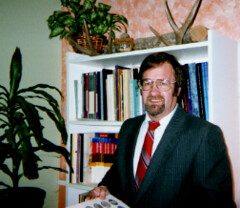 I wanted to let everyone know that my NEW online web site, WWW.COINCATS.COM is now up and running. Everyone is invited to look it over, check out the latest American numismatic literature offerings, and make any comments about what they see. Hopefully this will be user friendly and easily navigable.
I wanted to let everyone know that my NEW online web site, WWW.COINCATS.COM is now up and running. Everyone is invited to look it over, check out the latest American numismatic literature offerings, and make any comments about what they see. Hopefully this will be user friendly and easily navigable.
Along with plenty of coin auction catalogues and numismatic reference books for sale going back to the 19th century, feel free to check out a beginning database of postcards and stereo-views of the various U.S. Mint buildings (again, going back to the 19th century).
Several interesting articles by Karl Moulton that cover early U.S. coinage, and numismatic literature, and other things, can be found as well. These include previously unrecorded background about Joseph Wright and the Libertas Americana medal and information about the deluxe editions of the A.W. Browning book on early U.S. quarters.
To visit the web site, see: www.coincats.com
NEW BOOK: THE 1815 HALF EAGLE
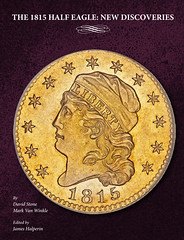 Heritage Auctions has announced the publication of The 1815 Half Eagle: New Discoveries, a 50 page monograph by Heritage numismatists David Stone and Mark Van Winkle, published by Ivy Press.
Heritage Auctions has announced the publication of The 1815 Half Eagle: New Discoveries, a 50 page monograph by Heritage numismatists David Stone and Mark Van Winkle, published by Ivy Press.
“This compact reference contains a comprehensive study of the 1815 half eagle,” said Jim Halperin, Co-Founder of Heritage, who also edited the monograph, “one of the most famous and valuable rarities in the U.S. federal gold series. Although this issue has been diligently studied by numismatists for more than 150 years, many important facts relating to its history have only recently come to light.”
As detailed in this meticulously researched booklet, new findings in the National Archives by Roger W. Burdette have yielded important information about the first appearance of the 1815 along with some never-before-published correspondence between Mint officials establishing the pedigree of the Mint Cabinet specimen, which was only acquired in 1885. In addition, this volume includes the story of the long-reported specimen in the Royal Coin Cabinet of Sweden.
Renowned collector Joseph Mickley first discovered the 1815 in the Swedish collection in the early 1870s, but no American numismatist had actually seen the coin since that time despite repeated mentions in auction catalogs and periodicals over the ensuing 140 years.
The authors have traced the interesting history of this piece back to Swedish merchant Carl Scharp in 1844, and confirm its presence in the Royal Coin Cabinet by 1851, long before U.S. collectors were aware of its existence. A high-quality image of the coin in the Royal Mint Cabinet is published here for the first time in any numismatic publication.
The second half of the booklet consists of a detailed census of known specimens of the 1815 half eagle, with a separate section for each coin. This section includes valuable information on the history of each specimen along with images and physical descriptions. Regrettably, one coin that has been listed in most rosters of the 1815 half eagle compiled over the last 100 years has been proven to be an altered date 1813 half eagle instead.
“Students of this iconic early half eagle will find this reference indispensable,” said Halperin, “and anyone with even a casual interest in early U.S. gold coins will be fascinated by the exciting story of this important issue.”
The book is available for purchase at $20 on the Heritage Auctions web site, HA.com.
Heritage Auctions is the largest auction house founded in the United States and the world’s third largest, with annual sales of more than $800 million, and 700,000+ online bidder members. For more information about Heritage Auctions, and to join and receive access to a complete record of prices realized, with full-color, enlargeable photos of each lot, please visit HA.com .
NEW BOOK: JOHN J. FORD, JR., AND THE FRANKLIN HOARD
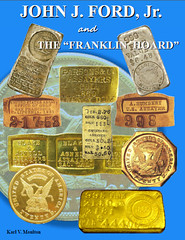 The final touches and edits on my book "John J. Ford, Jr., and the Franklin Hoard" are being applied at this time and publication is not far in the future.
The final touches and edits on my book "John J. Ford, Jr., and the Franklin Hoard" are being applied at this time and publication is not far in the future.
This is a rather large tome of over 900 pages that took over four years of writing, editing, and design (not to mention decades of research). Images of over 150 gold and silver bars, along with gold coins, that make up the “Franklin Hoard” and were marketed by John J. Ford from the early 1950's to the 1970's, are illustrated on 54 plates (most in color) and have seldom been seen or publicized before.
Color Illustrations include items such as Blake & Agnell, B. Baxter, Parsons & Co., Knight & Co., E. Posen, the so-called SS Brother Jonathan and the high fineness so-called "proofing" gold bars. Dozens of United States Assay Office of Gold (U.S.A.O.G.) pieces were marketed as original 19th century creations by Ford, and it turns out that many of these, including the P.N.G. arbitrated, 1853 U.S.A.O.G $20 proof gold coins, were modern 20th century fabrications (the 1853 U.S.A.O.G $20’s were made from transfer dies).
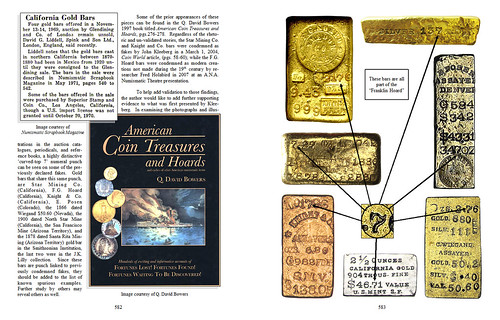
This work presents pedigrees and background on the buyers and sellers of gold bars prior to 1974, when gold ownership was again legalized for American citizens. Buyers, such as Keefer, Lilly, Murrell, and the Norwebs are examined. Sellers, such as Ford, Stack's, Franklin, and Painter are seen through invoices, letters, and historical documents. Then, there's the story of two assayers in Phoenix who worked directly with Gerow Paul Franklin...really!
Chapters include a year-by-year accounting of Ford's numismatic activities, with hundreds of personal letters and invoices relating to the "Franklin Hoard" pieces. The 1999 "Great Debate" is also chronicled and follow-up articles by other researchers are included. This book, with a great deal of previously unseen documentation, describes a fascinating and complex story; and will become the standard reference about a controversy that has shaken the numismatic world for decades.
Copies of the "John J. Ford, Jr., and the Franklin Hoard" book can be ordered at the pre-publication price of $250.00, by sending payment to:
Karl Moulton
PO Box 1073
Congress, AZ, 85332
After publication the price will be $295.00. Plans are to ship early next year. Questions can be directed to: numiscats@aol.com
Happy Holidays, Karl Moulton
NEW BOOK: FESTSCHRIFT FOR ILYA PROKOPOV
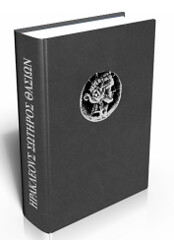 A new volume of essays has just been published in honour of Dr Ilya S. Prokopov, one of the leading Bulgarian numismatists and a world expert on modern counterfeits of ancient coins. He is best renowned for his die-studies on the Late Hellenistic silver coinages of Thasos (Berlin 2006) and the Macedonian Regions (Wetteren 2012).
A new volume of essays has just been published in honour of Dr Ilya S. Prokopov, one of the leading Bulgarian numismatists and a world expert on modern counterfeits of ancient coins. He is best renowned for his die-studies on the Late Hellenistic silver coinages of Thasos (Berlin 2006) and the Macedonian Regions (Wetteren 2012).
The new volume contains 47 contributions from distinguished scholars like M. H. Crawford, F. de Callatay, D. MacDonald, K. Liampi, C. Lorber, C. Marinescu, Y. Touratsoglou, S. Kremydi, D. Ujes-Morgan and many others, as well as from a number of younger students in ancient and medieval numismatics.
Essays cover a vast variety of topics – 33 of them are devoted to numismatic studies (with an emphasis on Hellenistic and Roman coinages) and 14 – to the archaeology and ancient history of the Balkans.
To read the complete article, see: Festschrift for Ilya Prokopov (www.coinsweekly.com/en/News/4?&id=1678)
For more information or to order, see: HPAKΛEOYΣ ΣΩTHPOΣ ΘAΣIΩN (www.faber-bg.com/index.php?mod=books_item&show=1765)
DANIEL BYRNE 1920-2006
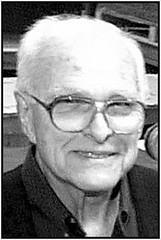 My grandfather, Dan Byrne, was a collector, Orders and Medals Society of America (OMSA) member and the author of comprehensive volumes on the medals and orders of Russia, France, Belgium, Vietnam, and other countries.
My grandfather, Dan Byrne, was a collector, Orders and Medals Society of America (OMSA) member and the author of comprehensive volumes on the medals and orders of Russia, France, Belgium, Vietnam, and other countries.
I remember as a small child being in awe of his colorful collection, which adorned the walls of his TV room (what we'd now refer to as a man cave, I suppose) from top to bottom behind protective glass.
It was his wish after he died in 2006 at age 85 that his family sell his collection, including his library of books, which fell to me.
Anyone who's interested in the books is free to take a look at a list I've compiled online: https://docs.google.com/spreadsheet/ccc?key=0AkRAS5wUt3GzdHA1ajB3Sm05UkhfT2R0WXdWUXNMUFE#gid=0 .
I am attempting to sell them on eBay, but would happily work outside of that venue. Here is a link to the eBay store, and I'll be posting new books periodically for the next few weeks: stores.ebay.com/DanByrneMedalLibrary?_rdc=1 .
Dan was a meticulous but humorous man, a dedicated researcher and devoted storyteller who made many friends in your world. I've had a lot of fun researching these books and finding out more about them, and him.
His obituary is copied below. Feel free to contact me at senatorallen@gmail.com with questions.
Barbara Allen, Stillwater, Oklahoma.
BYRNE -- Daniel, cofounder of Plastic Engineering Company of Tulsa, died Wednesday, May 10, 2006, at the age of 85. Dan was born in Tulsa on July 11, 1920. He graduated from Marquette High School and the University of Tulsa as a Chemical Engineer. He was an avid TU football fan, and never passed up a chance to discuss the exploits of Glen Dobbs. In 1941, Dan married Margaret Bath, and the union lasted 49 years until her death in 1990.
During World War II, Dan worked at Douglas Aircraft where he learned the techniques of thermoforming acrylic sheet into aircraft canopies. After the war, he and Margaret started the Plastic Engineering Company in their home. Soon, the business moved to a storefront near 9th and Denver. Today the company is located at 6801 E. 44th Street and is operated by second and third-generation family members.
Dan was considered an expert on automatic sidearms and helped found the National Automatic Pistol Collectors Association. He later became interested in international militaria and compiled one of the finest collections of military decorations and orders in the United States. Recognizing a need for definitive references, he authored collectors' guides for the medals of Belgium, France, Russia and Vietnam. Dan is survived by: his son and daughter-in-law, Denny and Mary; his grandchildren, Barbara (Allen), Virginia (Gleason) and Matthew (Byrne); his great-grandchildren, Vivian Allen and Georgia Gleason.
To read the complete article, see: BYRNE -- Daniel (www.tulsaworld.com/ourlives/article.aspx?subjectid=58&articleid=060512_Ob_obsn3794698)
THE NOVEMBER/DECEMBER 2012 ISSUE OF MONETA
 The November/December issue of moneta, the journal of the Ottawa Numismatic Society, is now available online at www.ons-sno.ca. In this issue:
The November/December issue of moneta, the journal of the Ottawa Numismatic Society, is now available online at www.ons-sno.ca. In this issue:
Beware of the creep! [François Rufiange]
Vignettes of Santa Claus [Steve Woodland]
A numismatic adventure of the Boston transit system [Ron Cheek]
Benjamin Franklin: Philadelphia’s Renaissance man [Kim Zbitnew]
Numismatic story end on a high note [Wilfred Lauber]
Merry Christmas to all, may 2013 be filled with health, happiness, and great numismatic adventures!
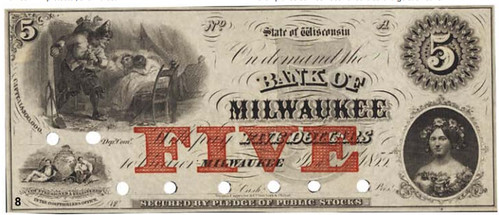
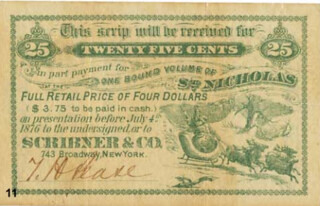
25-cent scrip issued by Scribner & Co. new York
To read the complete issue, see: November/December 2012 (www.ons-sno.ca/Moneta_2012_11_12_PV.pdf)
NOTES FROM E-SYLUM READERS: DECEMBER 23, 2012
Mark Hillary 1796 Half Cent Variety Identified
Bill Eckberg writes:
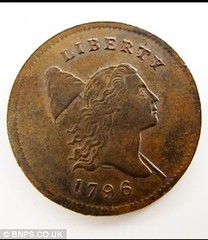 The variety is easy. Pole-to-cap identifies it as Cohen 2, the "more common" of two varieties, but still scarce, highly prized and, if genuine and really UNC, should bring far more than their estimate. The mintage, however, is a guess. It is almost impossible that the mintage can be 1,390 as the hype suggests. There are two varieties, one of which is badly cracked from the beginning, and the other is fine throughout the run. It would have taken only a couple of hours at the time to strike 1,390 coins, so the notion that they were struck on the same day or nearly so makes no sense, so that can't be the whole mintage for the year. It is far more likely that the actual mintage of 1796 half cents totaled 6,480, delivered in April, June and October.
The variety is easy. Pole-to-cap identifies it as Cohen 2, the "more common" of two varieties, but still scarce, highly prized and, if genuine and really UNC, should bring far more than their estimate. The mintage, however, is a guess. It is almost impossible that the mintage can be 1,390 as the hype suggests. There are two varieties, one of which is badly cracked from the beginning, and the other is fine throughout the run. It would have taken only a couple of hours at the time to strike 1,390 coins, so the notion that they were struck on the same day or nearly so makes no sense, so that can't be the whole mintage for the year. It is far more likely that the actual mintage of 1796 half cents totaled 6,480, delivered in April, June and October.
To read the earlier E-Sylum article, see: THE MARK HILLARY 1796 HALF CENT (www.coinbooks.org/esylum_v15n52a18.html)
On eBay's Counterfeit Banknote Policy
Joe Boling writes:
You asked, about the paper NORFED notes, "So what's the status of the paper issues?" What indeed is the status of counterfeit paper on eBay? If their policy is to ban "the listing of counterfeits and replicas on eBay.com," they have a long way to go in the paper field. For starters, their originally-published position was ambiguous about paper offerings - it was specific only about metallic lots.
I regularly see offerings of banknotes with spurious overprints/overstamps, where the additional marking makes a $5 note a $500 note - except that so many are showing up that the prices are falling through the floor. Bad news for the very few people selling genuine examples of these issues - their offerings draw 15% of their true value. When you leave feedback that a lot was a fake (if you give two stars or fewer for "description," they come back and ask you why), eBay does nothing. One seller in England has used three eBay names - all the payments go to the same PayPal account. Since eBay owns PayPal, they should certainly be able to figure this out.
To read the earlier E-Sylum article, see: LIBERTY DOLLAR SALES BANNED ON EBAY (www.coinbooks.org/esylum_v15n52a13.html)
Mystery Numismatists Identified
In an earlier issue I published a quiz, asking if readers could identify the two mystery numismatists pictured here.
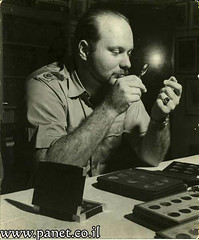
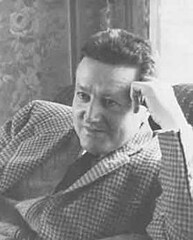
When no one came forth I gave the following hint: The first one was NOT a U.S. citizen, and lived in a palace. The second one was a controversial academic.
Ron Guth writes:
OMG, I can't believe no one identified either of the two numismatists. The one on the right is Dr. William H. Sheldon. No clue on the other guy.
Greg Adams writes:
With respect to your pictures I don’t know who the gentleman on the left is but the one on the right is Dr. Sheldon.
Chuck Heck writes:
I have no idea who is in the first of the two photos but I definitely know the second is Dr. William Sheldon.
Pete Smith writes:
I didn't answer last week because I thought it was too easy. King Farouk and Dr. William "MS-70" Sheldon.
To read the earlier E-Sylum article, see: MORE ON THE NUMISMATIC GREATS (www.coinbooks.org/esylum_v15n52a10.html)
Harvey Stack Inducts Abe Kosoff
Speaking of famous numismatists, Pete Smith adds:
To read the compete article, see: Set Registry Scrapbook ANA Philadelphia, August, 2012 (www.pcgs.com/SetRegistry/ImageGallery.aspx?gID=79&Page=4)
On the MAGnite System for Counterfeit Detection
Joe Boling writes:
Evidently the Giesecke and Devrient MAGnite system for checking authenticity of banknotes has not been used by anyone yet for a circulating note, as their website shows no examples of the system in use - not even on a test note. I'd love to see before-and-after images showing the effect of the magnetic field on the printing ink.
To read the earlier E-Sylum article, see: A SMARTPHONE APP FOR COUNTERFEIT DETECTION (www.coinbooks.org/esylum_v15n52a14.html)
Joe Boling on the Translation of "Nummis Nova"
Joe Boling writes:
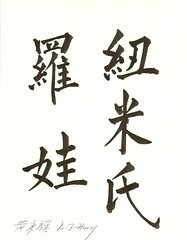 The calligrapher who wrote out Nummis Nova in Chinese is using the phonetic values of the characters, and even then they don't really make what you want. My dictionary reads it as niu-mi-shih lo-wa. Literally it's [cord-uncooked rice-family/clan] [silk-beautiful woman].
The calligrapher who wrote out Nummis Nova in Chinese is using the phonetic values of the characters, and even then they don't really make what you want. My dictionary reads it as niu-mi-shih lo-wa. Literally it's [cord-uncooked rice-family/clan] [silk-beautiful woman].
To read the earlier E-Sylum article, see: WAYNE'S NUMISMATIC DIARY: DECEMBER 16, 2012 (www.coinbooks.org/esylum_v15n52a17.html)
More on Yap Stone Money
Ralf Böpple of Stuttgart, Germany writes:
With regard to your paragraph on stone money in last week's E-Sylum, there's even a Stacks-Bowers auction appearance of such a "coin", giving some more background.

The "Holy Grail" of Primitive Money, Yap Island Stone Money, "The World's Largest Coinage"
18 inches x 3.5 inches; 54 pounds. Opitz-pg.316/21; Quiggin-pg.144, pl#12; Sigler-pg,19; Gillilland-Smithsonian Institute "The Stone Money of Yap a Numismatic Survey"-pg.58-type-d.. Yap Island produced the worlds largest and heaviest coinage, most commonly referred to as "Fei" or "Rai", considered sacred amongst the local people. The largest examples are in excess of 12 feet in diameter, weighing about 2 tons. Due to their excessive size the larger stones often traded ownership without physically being moved. The larger stones would remain in place as it became common knowledge among the inhabitants that it now belonged to a new owner. As there is no large source of stone on Yap, the stones were quarried and shaped on the island of Malakal in Palau, then shipped back to Yap on native boats. The stones are made of calcite, which is abundant on Malakal. Some of the larger stones took as long as two years to quarry and shape using axes made from giant clams. The trip from Malakal to Yap via boat was a hazardous voyage that claimed many lives. Often the value placed on a stone directly related to the amount of human lives lost in order to quarry it and deliver to Yap.
Although there are many sizes and shapes of Yap stones, they can be classified into two basic types pre and post O'Keefe. The earliest stones were produced by the locals using axe heads made from segments of the giant clam. Later stones or "O'Keefe stones" were produced in the 1800's using metal tools. David O'Keefe was American of Irish heritage who came to Yap with tools and a junk boat acquired in Hong Kong which he used to quarry and transport "Fei" from Malakal to Yap and through this process set himself up as the King of Yap Island. The 1954 motion picture "His Majesty O'Keefe" starring Burt Lancaster, although somewhat dramatized and engrossed, fairly accurately portrays this series of events.
The stone offered here is of the pre O'Keefe type, quarried and shaped by the native Yapese using the traditional axes made from giant clam shells. In terms of size, this is one of the larger pre O'Keefe stones we have seen offered for sale, weighing 54 pounds. Seldom are larger stones available for sale, as removing them from the island was extremely hard due to their size and weight. In terms of condition this stone is complete, unbroken and attractive. Often referred to as the key or "Holy Grail" to assembling a collection of primitive money.
To read the complete lot description, see: stacksbowers.com/auctions/auctionlot.aspx?lotid=297409
THE BOOK BAZARRE
WEIGHING SLABBED COINS
Bob Lyall writes:
On the subject of "slabbing", perhaps Dave Lange (of NGC) would "take on board" the problem that slabbing creates with some series of coins like the Portuguese and Brazilian "joes" (gold 6,400 reis) many of which are contemporary forgeries but when slabbed can't be weighed which is all important to identifying forgeries. Likewise, I've even seen West Indian cut/countermarked coins slabbed so their weights can't be determined. The practice seems to be extending into British hammered coins where, once again, weight is often important.
It would be helpful if instructions on how to extract the enclosed coin could be printed on the slab label.
To read the earlier E-Sylum article, see: MORE ON SLABBING NORWEB COINS (www.coinbooks.org/esylum_v15n52a07.html)
AMERICAN CAN COMPANY AND THE GIORI TEST NOTES
What’s in the Collection?
By Wilma Townsend
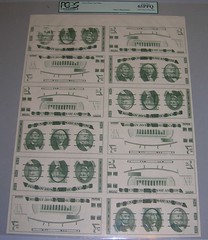 In the late summer of this year, Terry Smith of Smitty’s Coin and Currency, Canandaigua, generously donated to OCHS a sheet of Giori Test Notes that was printed on a press designed by American Can Co. engineer Edgar L. Pigman and built in Geneva, NY in the 1970s. Because of the rarity of such notes and their local connection, he felt that one of the sheets should be preserved at the museum. Below is a brief history of the test notes, written by Terry:
In the late summer of this year, Terry Smith of Smitty’s Coin and Currency, Canandaigua, generously donated to OCHS a sheet of Giori Test Notes that was printed on a press designed by American Can Co. engineer Edgar L. Pigman and built in Geneva, NY in the 1970s. Because of the rarity of such notes and their local connection, he felt that one of the sheets should be preserved at the museum. Below is a brief history of the test notes, written by Terry:
“In 2012, Smitty's Coin and Currency, Canandaigua, NY announced the verification of a newly discovered hoard of Giori Test Notes that were printed on a press designed and built in Geneva in the 1970s. PCGS Currency, the most respected company in currency grading and authenticating, recently released some of the notes back to Smitty's. Being called the "Edgar L. Pigman Hoard", these notes are recognized to have significant local and national historical value.
Until recently, these test notes were almost forgotten, with only the nephew of the late design engineer, Edgar L. Pigman, being aware of their existence. The American Bank Note Company, a subcontractor for the US Bureau of Engraving and Printing contracted Edgar, an engineer for the American Can Company's Geneva location, to design the press.
These Geneva-made machines were shipped to Washington, DC and using "nonsense plates" from the BEP were used to print the notes in sheets of 32. These plates have about 30-34 different vintages from a variety of notes. Most recognized are Washington $1, Lincoln $5, and Grant $50 bills. These notes were not legal to possess since they somewhat resembled real currency, even though there were no denominations. Only with a change in the BEP policy are these rare notes now legal to be bought and sold.
The History of the PCGS Certified Pigman Horde - Giori Test Note
To understand the significance of the Giori test notes requires a little history of United States Currency. At the conclusion of WWII, Gualtiero Giori created what was eventually known as the Giori Press. This groundbreaking method allowed two-color and even three-color engraving from a single plate, in one pass. Using precisely cut special rubber inking rollers, this allowed the application of each ink selectively to parts of the same plate. Adding to the new faster drying ink and other new technologies, a new press was to be commissioned by the Bureau of Engraving and Printing (BEP), many times faster than anything before it.
In a strange (and still not completely understood decision, American Bank Note Company (ABN) chose American Can as the subcontractor to actually create the new printing machines. Founded in 1901, the American Can Company was mostly known for the making of tin cans and their labels. They had manufacturing facilities nationwide, but chose the Geneva, NY plant as the site for building the press. Edgar L. Pigman (1932-2008) from Phelps, NY was selected as the American Can engineer to work on the project.
Mr. Pigman designed the presses and tested them using the Giori process. These plates display approximately 32 different vignettes, including portraits of Presidents Washington, Lincoln and Grant that are identical to those on the $1, $5 and $50 Federal Reserve Notes that were then current in circulation. While the presses worked fine in Geneva (making these test notes), and were delivered to DC, they were never used for making any currency that went into circulation. There is no proof the presses were ever used once they made it to Washington DC.
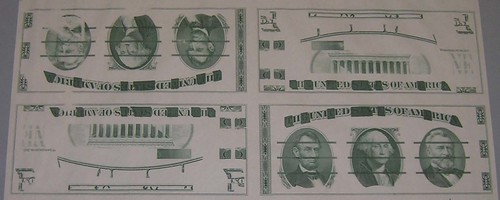
Many stories have circulated about the entire situation, and all are not completely understood or officially confirmed. It does not seem coincidental that this large waste of taxpayer dollars was soon followed by the Director of the BEP resigning, and a well-documented lawsuit to follow against him. Pigman's nephew talked about his uncle being unhappy about the entire situation, even though he had long since moved on to other projects. The test notes sat in his closet, undisturbed for 30+ years.
Originally they were considered by the BEP as illegal for collectors own, since they somewhat resembled authentic circulating currency, but the restriction on private ownership has since been lifted. The test notes in this portfolio are one of the largest groups to ever become available to the collection community.”
If you would to see the sheet of Giori test notes, please call 585 394-4975 or email curator@ochs.org.
REPORT DETAILS US MINT TESTING OF NEW COIN MATERIALS
When it comes to making coins, the Mint isn't getting its two cents worth. In some cases, it doesn't even get half of that.
A penny costs more than two cents and a nickel costs more than 11 cents to make and distribute. The quandary is how to make coins more cheaply without sparing our change's quality and durability, or altering its size and appearance.
A 400-page report presented last week to Congress outlines nearly two years of trials conducted at the Mint in Philadelphia, where a variety of metal recipes were put through their paces in the massive facility's high-speed coin-making machinery. Evaluations of 29 different alloys concluded that none met the ideal list of attributes. The Treasury
To test possible new metal combinations, the U.S. Mint struck penny-, nickel- and quarter-sized coins with "nonsense dies"—images that don't exist on legal tender (a bonneted Martha Washington is a favorite subject) but are similar in depth and design to real currency.
Test stampings were examined for color, finish, resistance to wear and corrosion, hardness and magnetic properties. That last item might be the trickiest, as coin-operated equipment such as vending machines and parking meters detect counterfeits not just by size and weight but by each coin's specific magnetic signature. Except for pennies, all current U.S. circulating coins have the electromagnetic properties of copper, the report said.
A slight reduction in the nickel content of our quarters, dimes and nickels would bring some cost savings while keeping the magnetic characteristics the same. Making more substantial changes, like switching to steel or other alloys with different magnetic properties, could mean big savings to the government but at a big cost to coin-op businesses, Peterson said.
Another challenge for the Mint is the rising cost of copper (used in all U.S. coins) and nickel (used in all except pennies). Only four of the 80 metals on the periodic table—aluminum, iron (used to make steel), zinc and lead—cost less than copper and nickel, the report stated. Lead isn't an option because of its potential health hazards.
Concurrent Technologies Corp., a Pennsylvania-based scientific research and development company, is working with the Mint on the alternative materials study under a $1.5 million contract awarded in 2011.
To read the complete article, see:
US Mint testing new metals to make coins cheaper
(www.denverpost.com/business/ci_22229721/us-mint-testing
-new-metals-make-coins-cheaper)
U.S. MINT 2012 ALTERNATIVE METALS STUDY

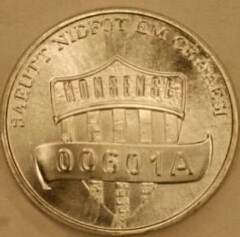
Nonsense Cents
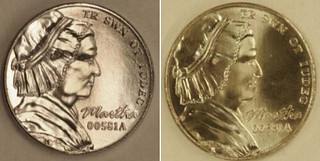
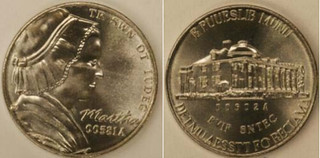
Nonsense Nickels
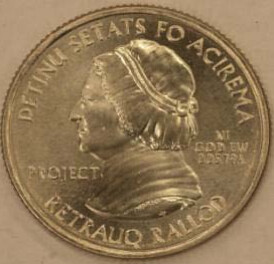
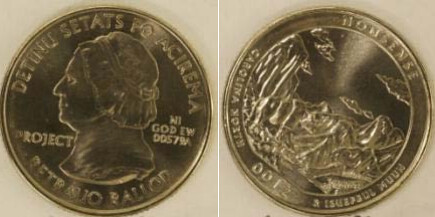
Nonsense Quarters
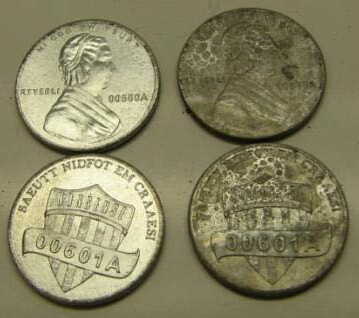
Corrosion test set
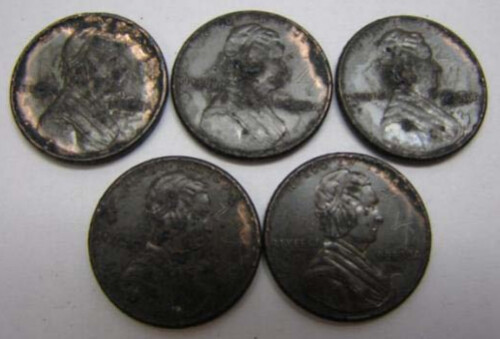
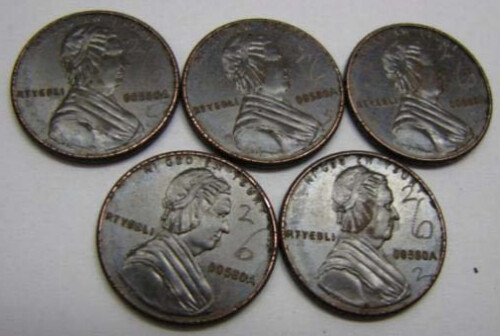
Wear test sets
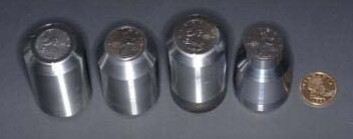
Die progression set: master hub, master die, working die, coin
To read the complete report, see:
ALTERNATIVE METALS STUDY
(www.usmint.gov/about_the_mint/PDFs/Current_Technologies_Corporation
_Report_Alternative_Metals_Study_August_31_2012.pdf)
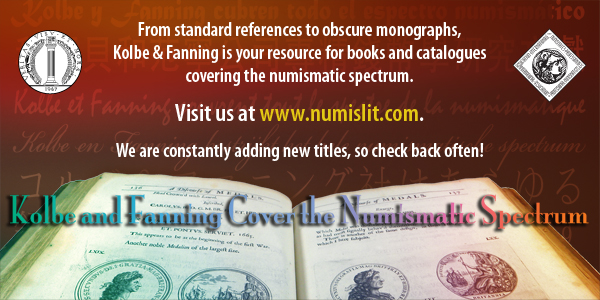
CENTRAL STATES NUMISMATIC SOCIETY BANS LIBERTY DOLLARS
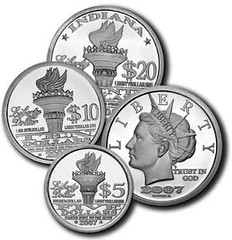 So-called Liberty Dollars, the creation of Bernard Von NotHaus and the National Organization for the Repeal of the Federal Reserve Act and the Internal Revenue Code, more commonly known by the acronym NORFED, will not be part of the April 24-27, 2013 74th Anniversary Convention of the Central States Numismatic Society in Schaumburg, Illinois, according to a statement issued by convention General Chairman Kevin Foley.
So-called Liberty Dollars, the creation of Bernard Von NotHaus and the National Organization for the Repeal of the Federal Reserve Act and the Internal Revenue Code, more commonly known by the acronym NORFED, will not be part of the April 24-27, 2013 74th Anniversary Convention of the Central States Numismatic Society in Schaumburg, Illinois, according to a statement issued by convention General Chairman Kevin Foley.
In making his announcement, Foley said, “Although this alternative monetary instrument has been available on coin convention bourse floors since its 1998 introduction, and has from time to time been the subject of educational exhibit area displays, the 2011 federal court conviction of Mr. von NotHaus in connection with his role as what one numismatic press outlet characterized as the “monetary architect” of the Liberty Dollar on the basis that the Liberty Dollar is counterfeit, has led us to adopt a policy to exclude such items from our bourse floor and educational exhibit area for our Schaumburg and future conventions.”
Foley added, “While we are aware that the underlying criminal conviction of Mr. Von NotHaus has been the subject of considerable controversy and criticism, the fact remains that the government agency charged with the enforcement of counterfeiting laws, the Secret Service, has issued a determination that the Liberty Dollars are, in fact, counterfeit. As a numismatic convention sponsor we have no basis to treat this product any differently than we would other monetary instruments so classified by the Secret Service.
We also take note of the fact that eBay will no longer accept listings on its website for the Liberty Dollar and has recently initiated a process of cancelling site listings that offer the Liberty Dollar. Until such time as the Secret Service adopts a position contrary to its current findings with respect to the Liberty Dollar, this is a product that will no longer be available in our convention bourse area nor will educational displays including it be permitted.”
To read the complete article, see:
Central States Convention Bans Liberty Dollars
(www.coinweek.com/education/central-states-convention
-bans-liberty-dollars/)
DO LIBERTY DOLLARS DESERVE TO BE BANNED?
As noted in the previous article, eBay and the Central States Numismatic Society have banned Liberty Dollars from their venues. Humbug! I'm too young to be an old hippie, but I think the government is way overreaching on this. I understand CSNS' position, but wish the numismatic community would take a stand on the issue. Fighting these fights isn't always futile. The hobby worked with the government to roll back oppressive rules on the trading of Confederate currency, and the lawsuit over the seized Farouk 1933 $20 gold piece resulted in its legalization. Are we all gonna be weenies and roll over on this one?
Probably. There may be a small collector community for Liberty dollars, but no powerful hobby voices with a vested interest. But if Liberty Dollars are banned, what about other alternate currencies, past and present? Are Ithica Hours counterfeits? What about Nickolas Veeder's Eutopia dollars or Lewis Feuchtwanger's issues? They were proposed alternative coins, too.
Their issuers were never accused of counterfeiting like Liberty Dollar maker von Nothaus, of course. With his wink-wink-nudge-nudge marketing spiel he built a multilevel army of distributors and shovers who eagerly bought the coins at a discount and resold or spent them at a profit. It was a scam masked as a political statement, and deserved to be shut down. But it's not the coins' fault. Von Nothaus may end up in jail, but his coins shouldn't be imprisoned as well. They are now historical artifacts deserving of a place in numismatic collections.
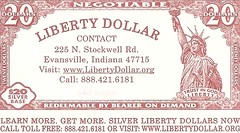 A Liberty Dollar distributor's business card
A Liberty Dollar distributor's business card
 If you ask me, the prosecution's case against von Nothaus is like the tax-evasion gambit that put Al Capone behind bars. They couldn't get him on racketeering charges, but nailed him for tax evasion instead. With von Nothaus they couldn't find a crack in his free speech shield, but instead made a claim that his coins were counterfeits, even though they were no more likely to be mistaken for an official U.S. coin than a Chuck E. Cheese token. Seriously, do these look like counterfeits to you?
If you ask me, the prosecution's case against von Nothaus is like the tax-evasion gambit that put Al Capone behind bars. They couldn't get him on racketeering charges, but nailed him for tax evasion instead. With von Nothaus they couldn't find a crack in his free speech shield, but instead made a claim that his coins were counterfeits, even though they were no more likely to be mistaken for an official U.S. coin than a Chuck E. Cheese token. Seriously, do these look like counterfeits to you?
I feel compelled to state that the above opinions are mine alone, and do not reflect a position of NBS. I'd be curious to hear what readers think about this issue. Meanwhile, I bolstered my ephemera collection on eBay this weekend. Here are images of a couple different Liberty Dollar brochures and a merchant window sticker. Gee, this would help make a great exhibit...
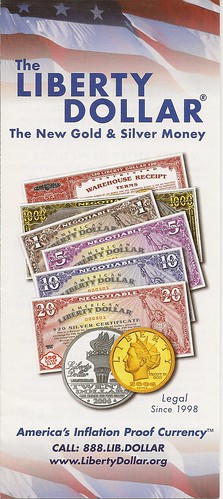
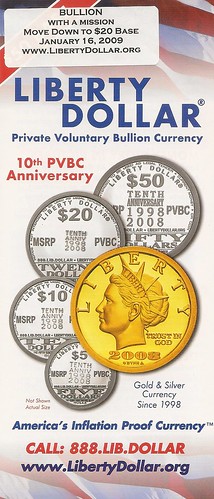
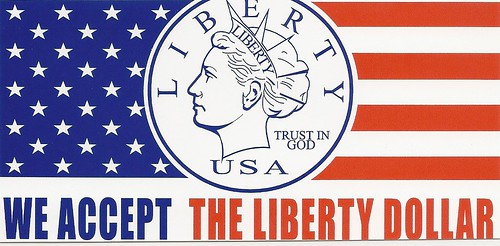
MORE ON G. B. DEBERNARDI AND THE LABOR EXCHANGE MOVEMENT
Loren Gatch writes:
I noticed your recent discussion of labor exchanges and meant to send you the attached article. It’s a good overview of the movement. There is another historian named Grant who’s also written on them. But otherwise, there really isn’t much known.
Magliari’s article has a list of exchanges at the end of his article. I don’t what his source for that is. But I do see several towns in Oklahoma listed. Do you know perchance if any of the Oklahoma exchanges actually existed, and issued notes? If I knew of any, I’d make the effort to look through the historical society’s newspaper archives.
Loren writes:
Of the four towns listed, two (Bernardi and Bellmont) are ghost towns--that's pretty common in Oklahoma history. Of course, the very name "Bernardi" suggests it was settled by Labor Exchange enthusiasts! Bernardi was located in Major County, NW Oklahoma, near the Kansas border. If it was really the #3 exchange, That suggests Bernardi was one of the very earliest of these exchanges.
 In Steve’s list Aline is #3 and Bernardi is #103. Magliari’s article says #103 is Walthall. Perhaps Bernardi changed its name at some point. Here’s the Magliari list.
In Steve’s list Aline is #3 and Bernardi is #103. Magliari’s article says #103 is Walthall. Perhaps Bernardi changed its name at some point. Here’s the Magliari list.

To read the earlier E-Sylum article, see: MORE ON LABOR EXCHANGE NOTES (www.coinbooks.org/esylum_v15n52a12.html)
QUERY: MEDICAL MEDAL DONOR IDENTITY AND NEW DONORS SOUGHT
Who was this collector?
Can we guess identity of a collector by looking at his collection? Maybe the collective knowledge of the readers can point me in the right direction.
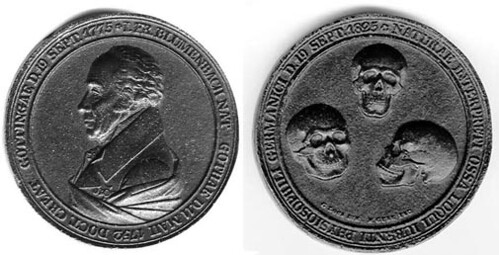
As some of you know I am in charge of the Rare Book and Special Collections department of the Falk Library of the Health Sciences at the University of Pittsburgh (www.hsls.pitt.edu/about/libraries/falk/rarebook). I came across a nice collection of medals, which was buried and forgotten in the library’s offsite storage for who knows how many years. Above is an example of one of the medals.] There is no documentation accompanying this collection, no correspondence, no scrap of paper with a name or address which could help me to identify the previous owner. All I can infer comes from the artifacts themselves.
There are 44 medals, some dating as far back as the late 15th century though the bulk of the collection dates from the 19th and early 20th centuries. Most of the medals in the collection are devoted to men famous in the field of medicine. A few do not match these criteria: there are four tokens and one coin among the medals, six medals are loosely or not connected to medicine at all (poet Schiller, Cardinal Mercier, French politicians and a First World War propaganda medal). However, the core of the collection has strict medical focus. I presented one medal from the collection in our newsletter.
Each medal was stored in a yellow envelope with a handwritten subject (all in the same penmanship) and was accompanied by a typed note card with a medal description and a catalog card with the name of the subject and additional information on the importance or relevance of the person to the field. There are more cards and envelopes than medals so I assumed that not all the medals were donated to the library. Out of 30 missing medals many commemorated really big personalities in medicine like Boerhaave, Charcot, Koch, and Leeuwenhoek. Maybe they were sold as more valuable before the rest was given to the library?
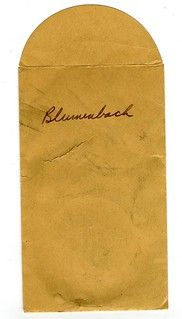
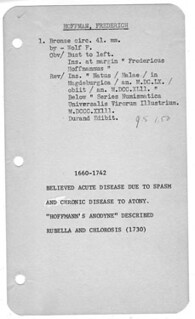
There are no medals issued after 1936, so I assumed that nothing was added to the collection since then. There is no indication when the medals were donated to the library, by whom and for how long they were stored in a box waiting for me to find them.
If my assumption is correct that the cards with descriptions were done by the owner, then I can also infer from the notes that he was a member of one of the local medical societies. Do any of you know of a doctor or medical researcher who was also a numismatist and active as a collector during the first half of the 20th century in Pittsburgh? Does anyone recognize the style of handwriting?
If you do, please contact me at gosia@pitt.edu
My wife, being a typical Polish academic, is too humble to ask for help in maintain and/or possibly improving this collection of medals that was found in the offsite storage area. The Medical Library’s rare book acquisition and maintenance budget can simply be summed up in the word — zero. The university pays for the reading room and climate controls as well insuring the collection but beyond that it receives nothing. The Rare Book collection totally depends upon gifts made by parties who are interested in having their books or other medical items retained in an academic institution where they can be made available for further study. It is my wife’s plan to catalogue and post the entire collection of medals (including photos) on the web site. However, she needs people’s help. Here is how you can aid this project:
1. Numismatic Literature. Neither the Medical Library or the university’s main library have any monographs on the subject of medicine and numismatics. Copies of Storer’s Medicina in Nummis, Freeman’s Medals Relating to Medicine and Applied Sciences in the Numismatic Collection of Johns Hopkins University and Forrer’s Biographical Dictionary of Medalists would be very helpful to say the least. My wife has been able to access copies via interlibrary loan but it would be far more convenient if she, and other researchers, had copies at hand in the rare book room. Likewise, any auction catalogues that have large collections of medals relating to medicine in them would be of immense use.
2. Actual medals. Numerous medals relating to medical research have been issued since 1936, likewise there are many from before that year which are missing from the collection. It would be wonderful if interested parties could continue to add to this group for future researchers.
3. Money. The library does not even have funds to pay for proper storage trays. I donated a couple but the spaces are two by two and many of the medals will not fit. Likewise, any monetary donations can go towards the acquisition of books to support research (see number 1 above) and the purchasing of material that adds to the collection.
Please remember that all donations are tax deductible!
A final word. Please contact my wife (gosia@pitt.edu) before you send any money, books or medals to make sure the collection needs them.

AN ART DECO ZEPPELIN MEDAL
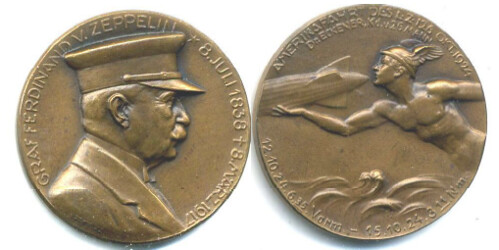
LZ 126 FLIGHT TO AMERICA, 1924. Kai. 451. 40mm. Bronze. (M&W) Choice About Uncirculated. Obverse bust of Zeppelin to the right wearing a cap; his name, birth & death dates around. On the reverse, a half length figure of Mercury holds the rear half of a zeppelin in his outstretched hand and guides
URSULA KAMPMANN REVIEWS NUMISMATIK LANZ AUCTION 155

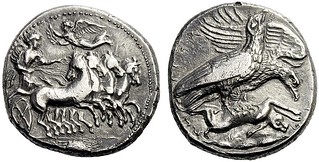

December 10/11, 2012
Numismatik Lanz, Auction 155
Numismatic rarities –Friedinger-Pranter Collection
A Feast for Collectors at Numismatik Lanz Auction 155
It was one of these auctions collectors love: In auction 155 of Numismatik Lanz items from old collections gathered with taste and dedication were sold. And no investors ballooned the prices to absurd spheres.
Auction 155 of Numismatik Lanz in Munich was an auction collectors dream of! Among other material the Friedrich-Pranter collection was sold featuring many eminent pieces with good provenances for the benefit of the Caritas aid organization. Thanks to that, rarely seen coin types rejoined the market, many of them in a sublime grade with a perfect collection patina.
Those sitting in the room had the advantage to react immediately when some piece could be bought at the opening price. At Numismatik Lanz, as you must know, a coin starts at 60 percent. (In post-auction sale the pieces can be purchased at 80 percent of the estimated price.) And for that reason many collectors’ faces beamed with joy about the acquired coins of the most distinguished provenance. Or would you hesitate to buy an extremely fine tetradrachm from Athens for 600 euros?
But, of course, not all pieces stayed at the starting price. Some of them saw a remarkable increase like a Celtic 1/24 stater of the Janus 1 type. It was called at 300 euros and knocked down, in the end, at 1,000 euros.
And there were even more remarkable results with the Greek coins. Let’s take for example a fantastic tetradrachm from Acragas in nearly extremely fine estimated at 6,000 euros. The starting price was 3,600 euros, the bidding ended only at a hammer price of 13,000 euros. And the man who purchased it was sure to have made a good deal! The same goes for an extremely rare, extremely fine and very interesting drachm from Gela minted with particularly fresh dies on both sides. It was estimated at 1,500 euros. The coin, hence, started at 900 euros and the hammer price was 3,200 euros.
One collector bought the arguably nicest oktodrachm of Getas, King of the Edones, really at a good price. The extremely rare and extremely fine showpiece was estimated at 50,000 euros. It climbed, though, from the starting price of 30,000 euros to 48,000 euros – and stayed thus only slightly below the estimate.
Oh, these perfect coins with an old collection patina, they scored particularly high results. Take, for example, a marvelous tetradrachm from the Roman province of Macedonia, nothing really spectacular, but simply beautiful (starting price: 300 / hammer price: 1,000 euros) or a perfect fraction from Aegina featuring a sea turtle (starting price: 300 / hammer price: 3,400 euros). And we also should not forget a tetradrachm of Mithradates showing his impressive portrait with flying hair (starting price: 2,400 / hammer price: 10,000 euros). Let’s conclude the Greek section by looking at a denarius of Iuba II and Cleopatra Selene mentioned in the auction preview already. This perfect piece started at 3,600 euros and the last bid of the lucky buyer was 7,500 euros.
The same could be observed with the Roman coins. Here, some collectors succeeded paying really collector-friendly prices, too. And those who paid more were delighted by the incredible quality of the purchased items as for example in the case of a denarius of Q. Pompeius Rufus featuring Sulla’s portrait. The extremely fine coin started at 600 euros but halted only at 5,200 euros.
Something similar happened with a sestertius of Tiberius that had been clearly underestimated. On the obverse the coin was extremely fine and showed two cornucopiae from which emerged the busts of Drusus’ twin sons. The coin was estimated at 500 euros, but, actually, the result was the octuple: 4,000 euros. This coin met exactly the expectation of collectors: honest quality and uncleaned surfaces. In these cases prices exploded. Indeed, it happened with many bronze coins as for example a dupondius of Trajan with a bright green patina (starting price: 300 / hammer price: 2,200 euros) or a sestertius of Crispina (starting price: 240 / hammer price: 1,050 euros) but as well with denarii like those of Hadrian (e.g. starting price: 240 / hammer price: 650 euros).
And rarities charged high in any case. The collectors spotted the extremely rare tetradrachm of Crispina from Alexandria in very fine (starting price: 300 / hammer price: 1,100 euros), the (fourrée) tremissis of Libius Severus III (starting price: 600 / hammer price: 2,100 euros), or the solidus of Constantinus VI and Irene (starting price: 1,800 / hammer price: 3,800 euros).
The auction’s highlight, however, was still to come! The Friedinger-Pranter Collection of medieval coins, particularly bracteats, showed a quality not seen on the market for a very long time. And here it was the same: those present in the auction room were clearly at the advantage. Some treasures stayed in quite reasonable limits, other prices exploded like a denarius from Nordheim showing a portrait of Henry the Fat on the reverse. Bidding started at 900 euros and halted only at 8,500 euros. Even higher was the result of a perfect bracteat from Arnstein displaying an archway, above, an eagle, below, a lion. This piece realized 9,500 euros. This is, indeed, an impressive price for a bracteat, concerning the artistry it is still a bargain. The same goes for the sum of 8,000 euros paid for a bracteat from Gelnhausen which shows the famous royal couple of Frederick Barbarossa and Beatrix side by side.
Today bracteats are quite cheap in proportion to their beauty. Just take these two examples: Hermann II of Thuringia, son of holy Elizabeth, issued a splendid bracteat showing himself as landgrave holding the banner riding on a dapple grey, in the background a building with three towers, probably a castle. This wonderful piece realized 850 euros. (And now think just for one moment about what Greek coin you could have bought for the same money.) A similar case is that of a bracteat in FDC minted in Lindau between 1230 and 1235. On the obverse it shows a lion in front of a lime tree with three leaves. The incredibly fresh item with its Romanesque execution of the animal realized 1,600 euros.
Quite remarkable were as well the prices paid by collectors for medieval coins from Tyrol. An extremely fine pfennig (though with some flatnesses) from the hoard of Naturns minted by Henry III of Berchtesgaden in Brixen realized 5,750 euros (starting price: 2,400 euros) and a very fine zwanziger of Egino of Eppan from Trient was knocked down at 3,000 euros (starting price: 300 euros). However, a denarius issued by Engelbert III and Meinhard II from the countship of Gorizia and minted in Lienz took the biscuit. The very fine piece climbed from a starting price of 3,000 euros up to 8,000 euros.
It certainly was worthwhile for all those who attended the Lanz auction 155. And the Caritas can be glad of the impressive results, too. Whoever wishes to buy some more coins from the Friedinger-Pranter Collection can do so online at www.taxfreegold.de
The auction catalogue and the prices realized are available online at www.sixbid.com/browse.html?auction=553
ROBERT O. EBERT COLLECTION OF ANCIENT COINS
The collection was meticulously assembled over a period of many years by accomplished engineer and businessman, Robert O. Ebert, the son of the founder of Rubbermaid. The analytical skill and care of an engineer is reflected in both the diversity and quality seen in this impressive, in-depth study of coins of ancient Rome.
Lot 5034. HADRIAN, A.D. 117-138. Gold Aureus
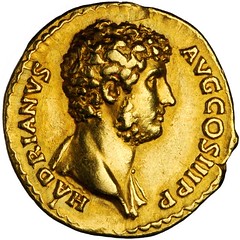

This remarkable type depicts a youthful portrait of Hadrian with sideburns rather than the full beard normally depicted on his portraiture. The reverse displays a very artistic depiction of the portraits of the Emperor’s adoptive parents, Trajan and the Empress Plotina. The reverse description “DIVIS PARENTIBVS” leaves little to interpretation as a deification issue of the emperors late adoptive parents. Both parents are depicted with stars above their portraits as a symbol of their deification. This tradition dates back to the reign of the emperor Augustus.
Early in the reign of Augustus when Halley’s comet passed over Rome, Augustus claimed it to be the spirit of Julius Caesar entering the heavens. The tradition of placing a star or comet on deification issues became somewhat regular occurrence as it appears on issues of August deification issue for Julius Caesar and Caligula issues deifying Augustus among others. Halley’s comet over the years has been associated with several historical events, including the battle of Hastings. Some theologians even believe the appearance of Halley’s comet may explain the biblical story of the “Star of Bethlehem”.
To read the complete lot description, see: stacksbowers.com/auctions/auctionlot.aspx?lotid=425469
Lot 5384. SABINA (WIFE OF HADRIAN). AV Aureus
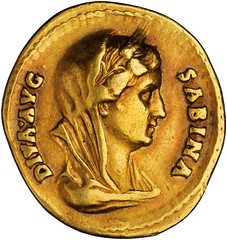
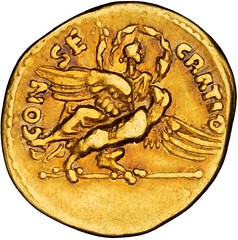
RIC-418b; Calico-1433 (this coin); Jameson-pl.XXI #441 (this coin). "DIVA AVG. SABINA." Her bust draped veiled and in wreath of corn-ears right; Reverse: "CONSECRATIO" Sabina holding sceptre with open scarf flowing behind her, borne aloft by an eagle right carrying a sceptre. VERY RARE deification issue of Sabina. Beautiful and stunning portrait style that was clearly engraved by an artist whose skill level was well above that of the average engraver. The reverse of this type depicts the late empress ascending into the heavens on the back of Jupiter’s eagle. Very attractive old collection toning with hues of orange and purple. A remarkable piece with excellent provenance.
To read the complete lot description, see: stacksbowers.com/Auctions/AuctionLot.aspx?LotID=425819
Lot 6074. NERO, A.D. 54-68. Sestertius
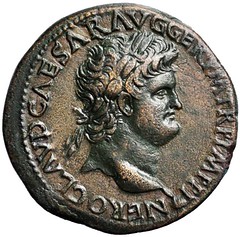
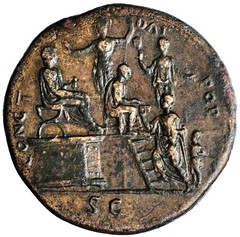
RIC-394. Laureate head of Nero right; Reverse: Nero bare-headed and togate seated right on curule chair on high platform on left, before him, an official seated right on another lower platform handing congiarium to togate citizen mounting steps and with boy attendant, in background on left, Minerva standing facing head left holding owl and spear and on lower level Liberalitas standing facing head left holding up tessera. Bold, well rendered portrait. Full legends, dark brown patina. Lightly smoothed.
To read the complete lot description, see: stacksbowers.com/Auctions/AuctionLot.aspx?LotID=426173
To read the complete article, see: http://www.stacksbowersauctions.com/collections/ebert-collection.aspx
HAWAII NOTES IN THE HERITAGE 2012 FUN CURRENCY AUCTION
Lot 15101: Kingdom of Hawaii Certificate of Deposit $20 1879
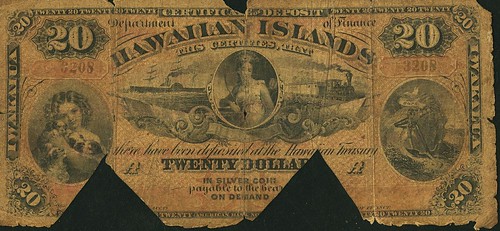
Hawaii Kingdom of Hawaii Certificate of Deposit $20 1879 (1880) Pick 2b
The reference, Hawaiian Money, by Donald Medcalf and Ronald Russell is the most comprehensive resource for Hawaiian numismatics. Still, little is known about the earliest currency issues of the islands and the rarity of the 1879 issue cannot be understated. According to Medcalf and Russell, discussion of government issued currency is known as early as 1845. Coinage of the United States and other governments filled the needs of commerce as well as a few private scrip issues. In 1859, the Hawaiian Government issued certificates of deposit, though only a lone survivor is known today. It is a $50 note that looks more like a check than a currency issue.
According to Medcalf and Russell, 200 of the $500 notes were printed and issued. They were all redeemed and no print runs were published in their book for the other denominations. Serial number ranges for the other notes indicate they were likely printed and released in quantities of 8,000 to 12,000, though the number of survivors is minuscule. The book's census of the 1879 issue shows only three uncancelled notes in private hands. A $50 example is listed by serial number, and a $10 and $100 are reported in private hands, but without confirmation by serial number. The only other uncancelled note is a $10 listed by serial number and resides in the Bishop Museum in Honolulu. Cancelled examples are much more common and likely number between 14 and 20. However, 10 of those examples are all locked up in the Hawaii State Archives.
After a breakdown of the research provided in Hawaiian Money, we estimate there are likely six to ten cancelled notes in private collectors hands, only three of them of the $20 denomination.
To read the complete lot description, see: currency.ha.com/c/item.zx?saleNo=3521&lotNo=15101
Lot 15102: Republic of Hawaii $5 Silver Certificate of Deposit 1895
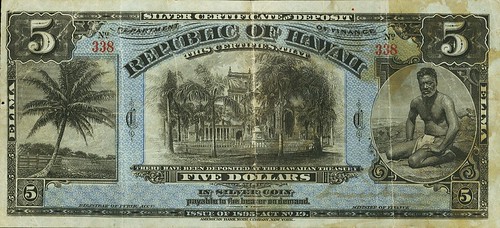
Hawaii Republic of Hawaii $5 Silver Certificate of Deposit 1895 (1897) Series C Pick 11
Years of political turmoil preceded Hawaii becoming a Republic on July 4, 1894. In 1895 the minister of finance was given the authority to issue currency under the auspices of the Republic. Currency issued was to be "payable to the bearer on demand without interest upon setting apart as a special deposit an equal amount of Gold Coin of the United States of America and Silver Coin of the Hawaiian Islands or the United States of America as security for the redemption of such certificates respectively."
A 100% metal backed issue was a rarity for most governments of the day, let alone a small enclave like the Republic of Hawaii. By 1897, notes in denominations of $5, $10, $20, $50, and $100 were printed by the American Bank Note Co. and ready for issue. The $5 and $10 silver-backed notes were issued in the largest but still paltry quantities of 10,000 for each denomination. Three years later, the islands became a territory of the United States and by 1905, all the currency issued under the Republic of Hawaii was demonetized.
According to Donald Medcalf and Ronald Russell's reference, Hawaiian Money, the last note presented for redemption in 1916. The Treasury records indicated just 15 of the $5 notes remained outstanding. As of the 1990 release of the second edition of their book, Medcalf and Russell recorded just eleven uncancelled survivors and two cancelled examples. The two cancelled examples were part of the Hawaii State Archives.
To read the complete lot description, see: currency.ha.com/c/item.zx?saleNo=3521&lotNo=15102
WILLIAM MURDOCK'S PEAT MOSS MEDALS
Murdock's ingenuity was constantly at work, even upon matters which lay entirely outside his special vocation. The late Sir William Fairbairn informed us that he contrived a variety of curious machines for consolidating Peat Moss, finely ground and pulverized, under immense pressure, and which, when consolidated, could be moulded into beautiful medals, armlets, and necklaces. The material took the most brilliant polish and had the appearance of the finest jet.
When I read this I wondered if the material Murdock invented was related to what we now call Bois Durci, or something similar to it (Murdock died before Bois Durci was invented in 1855). Bois Durci is "a process of taking sawdust, albumen or animal blood and hardening in a mould to form the desired object.... Various medals and medallions were made this way after being introduced at the 1862 London Exhibition of the Works of Industry of All Nations." (see the earlier E-Sylum articles on Bois Durci).
Is anyone aware of surviving medals made by Murdoch's peat moss process? Murdock was a contemporary of Boulton and Watt in London. Below is a photo from Wikipedia of a bronze statue of the three in in Birmingham, England.
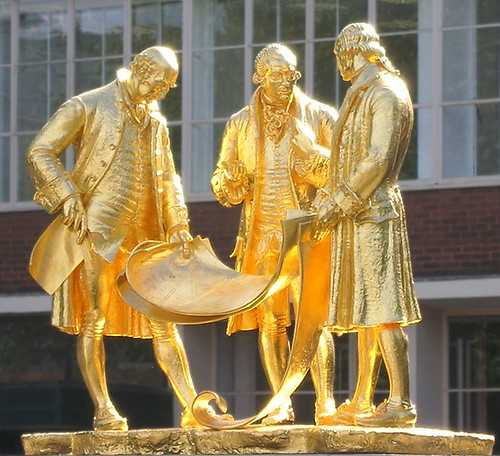
To read the complete passage, see: Men of invention and industry, Google Books
To read earlier E-Sylum articles on Bois Durci, see:
BOOK REVEW: BOIS DURCI, A NATURAL PLASTIC 1855-1927, BY GASTON VERMOSEN
(www.coinbooks.org/esylum_v11n36a04.html)
MORE ON BOIS DURCI
(www.coinbooks.org/esylum_v11n37a09.html)
POLICE IN PERU SHUT DOWN MAJOR COUNTERFEITING OPERATION
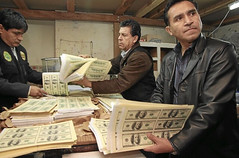 The Peruvian National Police (DIRINCRI - Direccion de Investigacion Criminal), in cooperation with the Brigada de Investigación Del Banco de España (BIBE), the US Secret Service and Europol were responsible for the operation.
The Peruvian National Police (DIRINCRI - Direccion de Investigacion Criminal), in cooperation with the Brigada de Investigación Del Banco de España (BIBE), the US Secret Service and Europol were responsible for the operation.
A total amount of 4.437.000 Euros and 4.460.000 US dollars in counterfeit banknotes were seized all 100 denomination notes. Printing equipment, including an offset press and materials for the production of banknotes, were also confiscated.
The raid was the culmination of an extensive operation that has been ongoing for a number of months and has involved information sharing across a number of international law enforcement agencies. A Europol expert was on the spot to provide technical support to Peruvian authorities and to evaluate the counterfeit Euro notes and machinery seized. Apparently the counterfeit Euros were distributed mainly in Spain and Portugal and the US dollars in the region.
“The dismantling of this print shop is the first case that Europol has supported on the spot in Peru and is a significant hit against euro and dollar counterfeit distribution. The success of this operation was made possible through the excellent work of the Peruvian authorities and their cooperation with Brigada de Investigación Del Banco de España (BIBE), the US Secret Service and Europol,” says Rob Wainwright, Director of Europol.
To read the complete article, see:
Major operation dismantles Euro and dollar counterfeit banknote printing in Peru
(en.mercopress.com/2012/12/19/major-operation-dismantles-euro
-and-dollar-counterfeit-banknote-printing-in-peru)
LUCKY 8888 SERIAL NUMBER DOLLARS POPULAR IN VIET NAM
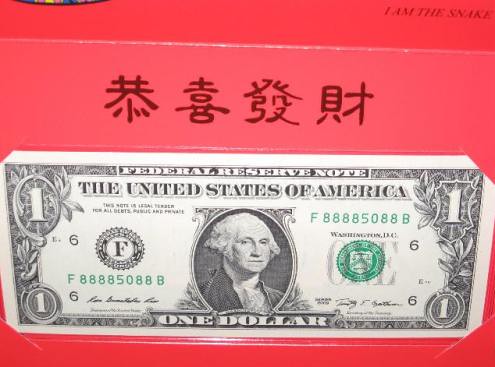
Right after the one-dollar bank note designed specifically for the 2013 Tet, the Year of Snake was marketed in the US some days ago, Vietnamese have been rushing to place orders for the lucky banknotes to prepare for the Tet celebration.
Official information sources say the one dollar banknote was launched into the US market in mid-November on the occasion of Orient people’s Tet. 88,888 one-dollar bank notes have been offered on sale by the US Treasury.
In Hanoi and HCM City, banknote traders have offered to sell the banknotes at 500,000 dong for each. Meanwhile, with the current exchange rate, one dollar is equal to 21,000 dong only.
The traders have advertised that these are the lucky banknotes which have been put into red envelops with printed images of snakes and with gilded Chinese letters. The bank notes are special because their series numbers all start with 8888, the numeral which is in thoughts of Oriental people, can bring good luck and prosperity.
Especially, clients can order a crystal box to put the banknote into it, if they accept to pay about one million dong for both the banknote and the box.
Analysts believe that even with the price level, Vietnamese traders still can make profit, because the original price announced by the US Treasury is 5.95 dollar per banknote only, while those, who buy more than 50 banknotes, would enjoy the preferential price level of 4.5 dollars.
On eBay, lucky one dollar bank notes have been offered at 6.95 – 8.68 dollars. Besides, buyers would also have to pay the shipping fee of five dollars for each time.
Besides the one dollar banknotes, people have also offered to sell the banknotes with special features. These include two dollar bank notes, which are believed to be in high demand, because the banknote is believed to bring good luck to the owners.
In general, older two dollar bank notes would be more expensive than brand new ones. For example, a two dollar bank note issued in 1976 would be priced at 300,000 dong, while the one issued in 1928 at 600,000 dong.
To read the complete article, see:
Lucky 1-dollar banknote worth half a million dong
(english.vietnamnet.vn/fms/business/55216/lucky-1-dollar-banknote
-worth-half-a-million-dong.html)
HUFFINGTON POST'S FAVORITE OLD BANKNOTES AND CURRENCY
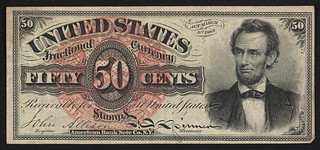
A $5 "brown back" national bank note from 1882 just sold for an eye-popping $101,790, according to Bonhams.
The bill barely resembles the kind of money that is printed today. In fact, the bill is a relic from an era when there were more than 8,000 different kinds of money in the United States.
A podcast this week by NPR's "Planet Money" dove into the currency crazy world of pre-Civil War America.
Before to U.S. nationalized its currency, the American money system was flooded with a seemingly infinite number of currencies, from state banknotes to local banknotes and different forms of change. There were bills adorned with Confederate heroes. Even Santa Claus made a cameo appearance on a Boston banknote.
NPR's podcast coupled with the sale of the $5 "brown back" encouraged us to dig around for some of America's most eclectic antique money.
To read the complete article (and view the photos), see: $5 1882 'Brown Back' Sells For $101,790, Causing Us To Dig For Some Of America's Craziest Currencies (PHOTOS) (www.huffingtonpost.com/2012/12/14/5-dollar-1882-brown-back_n_2279469.html)
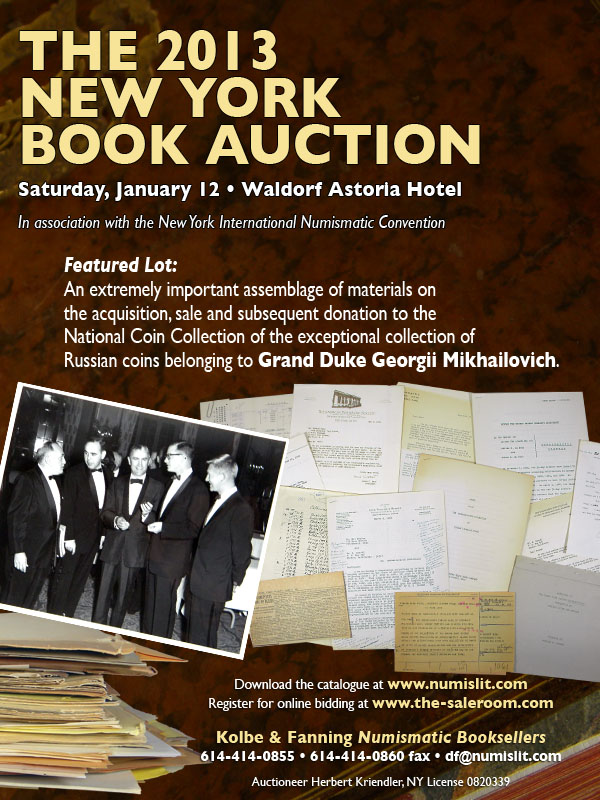
THERE IS NO SANTA CLAUS IN NUMISMATICS
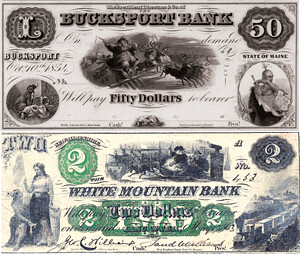
“There is no Santa Claus in numismatics,” Lee F. Hewitt, founder and editor of the Numismatic Scrapbook, said. The reference was to coins advertised as bargains. If a coin price seemed too good to be true, the coin had some problems.
Yet there is a Santa Claus in numismatics; he and his reindeer prance across the face of several different types and denominations of bills from state-chartered banks. At the top right is a proof $50 note from the Bucksport (Maine) Bank, dated October 10, 1854; below is a well-used $2 note of the White Mountain Bank of Lancaster, New Hampshire—each with a full hitch of eight reindeer.
Several different vignettes of Santa were used on currency during the 1850s, illustrated and described by Roger H. Durand in Interesting Notes About Christmas. Collecting such motifs has formed a specialty for quite a few collectors, with the result that just about any Santa Claus note is apt to draw a lot of interest when offered on the market.
Excerpted from 100 Greatest American Currency Notes, ©2007 Whitman Publishing, LLC.

To read the complete article, see: “There is No Santa Claus in Numismatics” (news.whitman.com/news/there-is-no-santa-claus-in-numismatics/)
THE "LAZY THREE" SANTA CLAUS NOTE
Last year we sent images of several different Santa Claus obsolete notes from our collection for a story in The E-Sylum. This year for Christmas, we have selected one of our favorite Santa's for the readers of the E-sylum. The $3, "Lazy Three" Santa Claus note comes from the famous Roger H. Durand Collection. This note, and around 30 more Santa Claus notes or related items, were part of the January, 2012 Heritage Signature FUN Currency Auction. A separate catalog was even prepared by Heritage for the Durand Collection. This $3, was Lot 15715 from that sale.
No one had ever assembled more Santa Claus notes then Roger Durand. There are seven different types of Santa Claus vignettes on obsolete notes, though the type seven is not known to exist. The six different types of Santa Claus vignettes will also be found on stock certificates and other numismatic items.
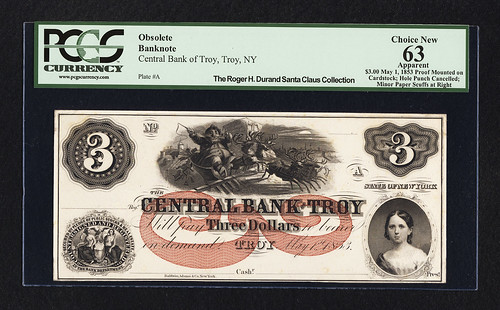
The Durand reference (Interesting Notes About Christmas by Roger H. Durand, 1993, 300 numbered copies) lists all the known Santa Claus notes and vignettes. With the six different types of vignettes that are known only three possible sets can be assembled. Our collection contains a complete type set of the six known vignettes. We have 22 Santa Claus notes in our collection. One of our favorites though, is the note we are using for this story. As you can see it is slabbed, as were all the Durand notes that were sold by Heritage in January, 2012 at the Florida United Numismatist sale in Orlando, FL.
Though the pedigree on the slab for this note is the Roger H. Durand Collection, it actually came to Roger from our collection. Some years back at the CPMX show in Rosemont, IL, we traded this Three Dollar Santa Claus Lazy Three note for a Newport, RI. William Newton & Co. 10 Cents Postage Stamp Affixed Note. At the time of the trade we only wanted to have a complete six type Santa Claus collection, and we already had this type in our collection. We originally purchased this and several other Santa Claus notes and vignettes along with a rare check from Len Glazer at a PCDA show in the late 1980s. The collection Len sold us was from the George W. Wait Collection. Many notes from the Wait collection, including this $3, are portrayed in a reference, Christmas Currency, An Illustrated Trial List by Larry L. Ruehlen, published in September, 1973. So the note we are using for this article is pedigreed to, Wait, Wilson, Durand and now back to Wilson. Only three or four notes are known to exist of this lazy three.
It is a $3 Proof, Mounted on Cardstock, Hole Punch Cancelled, Lazy Three, on the Central Bank of Troy, Troy, NY, dated May 1, 1853. Imprinted: Baldwin, Adams & Co., New York, it has a type three Santa Claus vignette at top center. A young lady is at right and on left a banking department seal. We hope you enjoy this great Santa Claus note.
From our house to yours, we want to wish all of the readers a belated Happy Hanukkah; and a Merry Christmas and Happy New Year. Yours in Numismatics and Friendship, John and Nancy Wilson, Ocala, FL
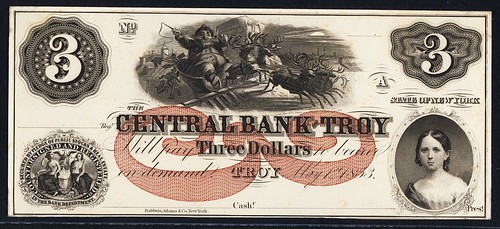
To read the earlier E-Sylum article, see: MERRY CHRISTMAS: SANTA CLAUS ON PAPER MONEY (www.coinbooks.org/esylum_v11n51a14.html)
A CHRISTMAS POEM: GIVE SANTA A MEDAL
Rich Jewell writes:
Here's a little Christmas poem I received from Joel Iskowitz (He did the Santa drawing, with a medal)! The poem was written by Dick Johnson.
Joel Iskowitz writes:
The drawing is my take off on an old Coca Cola ad with a classic Santa, which was illustrated by Haddon Sunblom. Dick just asked me for a quick sketch for the border of his Christmas poem for numismatists, so I borrowed and adapted Sunblom's old fashion, iconic Santa for this little poem. I can't imagine anyone wanting a copy of my take on Sunblom's Santa holding a medal, instead of a bottle of Coke, but I'll be happy to sign copies for anyone if they like.
BTW, it's difficult to tell whether the portrait on the medal is honoring James Madison, Howard Hughes, Kenny Rodgers or Hulk Hogan! That part is my whimsical completely original invention.
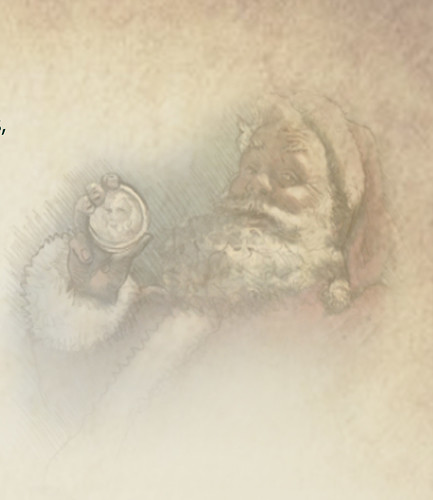 'Twas two days before Christmas,
'Twas two days before Christmas,
And my gift list complete.
Save one so important,
It had to be neat.
The gift I was missing,
The one to be handy,
For the spirit of Christmas,
So good for the family.
For the jolly ol' man,
Who arrives Christmas night.
Himself good and generous.
Choose a gift that's just right!
He travels a great distance,
To bring everyone good cheer.
What kind of a present
Would Santa hold dear?
No gingerbread houses,
No frilly white blouses.
No Hansel, no Gretle.
Give Santa a medal.
No toys to construct,
No parts to assemble.
No bicycle to peddle.
Give Santa a medal.
No milk, and no cookies,
By the tree and the rest.
Give Santa a medal,
He deserves just the best.
His effort rewarded,
In a box with red bow.
Give Santa a medal.
He's our Christmas He-Ro!
To read the earlier E-Sylum article, see: GIVE SANTA A MEDAL (www.coinbooks.org/esylum_v05n51a12.html)


